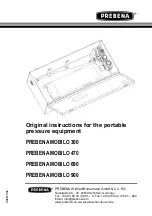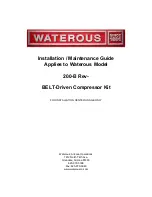
Section 8
TROUBLESHOOTING
35
8.1 TROUBLESHOOTING
The information contained in the Troubleshooting
chart is based upon both actual applied situations
and extensive testing at the factory. It contains
symptoms and usual causes for the described prob-
lems. However,
DO NOT
assume that these are the
only problems that may occur. All available data
concerning the trouble should be systematically
analyzed before undertaking any repair or compo-
nent replacement procedures.
A detailed visual inspection is worth performing for
almost any problems which may prevent unneces-
sary damage to the compressor. Always remember
to:
a. Check for loose wiring.
b. Check for damaged piping.
c. Check for parts damaged by heat or an
electrical short circuit, usually apparent by
discoloration or a burnt odor.
Should your problem persist after making the rec-
ommended check, consult your nearest Sullair rep-
resentative or the Sullair Corporation factory.
8.2 TROUBLESHOOTING GUIDE
SYMPTOM
PROBABLE CAUSE
REMEDY
COMPRESSOR
WILL NOT START
Main Disconnect Switch Open
Close switch.
Line Fuse Blown
Replace fuse.
Control Transformer Fuse Blown
Replace fuse.
Motor Starter Overloads Tripped
Reset. Should trouble persist, check whether motor
starter contacts are functioning properly.
Low Incoming Line Voltage
Check voltage. Should voltage check low, consult power
company.
Pressurized Sump
Check blowdown valve and minimum pressure check
valve for proper operation. Repair or replace as neces-
sary (kits available).
COMPRESSOR
SHUTS DOWN
Loss of Control Voltage
Reset. If trouble persists, check that line pressure does
not exceed maximum operating pressure of the compres-
sor (specified on nameplate).
Low Incoming Voltage
Consult power company.
Excessive Operating Pressure
Separator requires maintenance; check dP1 under full
load conditions.
High pressure shutdown parameter is adjusted too low;
readjust.
Defective blowdown solenoid valve; repair if defective (kit
available).
Defective blowdown valve; blowdown valve should
exhaust sump pressure to the atmosphere when maxi-
mum operating pressure is reached. Repair or replace as
necessary (kit available).
High Discharge Temperature
Cooling water temperature too high; increase water flow
(water-cooled).
Summary of Contents for LS20T 1100 CFM
Page 18: ...Section 2 DESCRIPTION 12 Figure 2 3B Control System Diagram START...
Page 19: ...Section 2 DESCRIPTION 13 Figure 2 3C Control System Diagram MODULATION...
Page 20: ...Section 2 DESCRIPTION 14 Figure 2 3D Control System Diagram FULL LOAD...
Page 21: ...Section 2 DESCRIPTION 15 Figure 2 3E Control System Diagram UNLOAD...
Page 44: ...NOTES 38...
Page 104: ...Section 9 ILLUSTRATIONS AND PARTS LIST 98 02250146 367R00 9 19 CONTROL START SYSTEM...
Page 106: ...Section 9 ILLUSTRATIONS AND PARTS LIST 100 02250146 367R00 9 19 CONTROL START SYSTEM...
Page 108: ...Section 9 ILLUSTRATIONS AND PARTS LIST 102 02250138 633R00 9 20 CONTROL PANEL...
Page 110: ...Section 9 ILLUSTRATIONS AND PARTS LIST 104 02250139 119R01 9 21 ENCLOSURE...
Page 112: ...Section 9 ILLUSTRATIONS AND PARTS LIST 106 02250139 119R01 9 21 ENCLOSURE...
Page 114: ...Section 9 ILLUSTRATIONS AND PARTS LIST 108 9 22 DECAL GROUP...
Page 116: ...Section 9 ILLUSTRATIONS AND PARTS LIST 110 9 22 DECAL GROUP...
Page 118: ...Section 9 ILLUSTRATIONS AND PARTS LIST 112 9 22 DECAL GROUP...
Page 120: ...Section 9 ILLUSTRATIONS AND PARTS LIST 114 9 23 DECAL LOCATIONS OPEN AIR COOLED...
Page 122: ...Section 9 ILLUSTRATIONS AND PARTS LIST 116 9 24 DECAL LOCATIONS OPEN WATER COOLED...
Page 124: ...Section 9 ILLUSTRATIONS AND PARTS LIST 118 9 25 DECAL LOCATIONS REMOTE COOLER...
Page 126: ...Section 9 ILLUSTRATIONS AND PARTS LIST 120 9 26 DECAL LOCATIONS CONTROL BOX...
Page 128: ...Section 9 ILLUSTRATIONS AND PARTS LIST 122 9 27 ENCLOSURE DECALS...
Page 145: ...NOTES 139...
















































